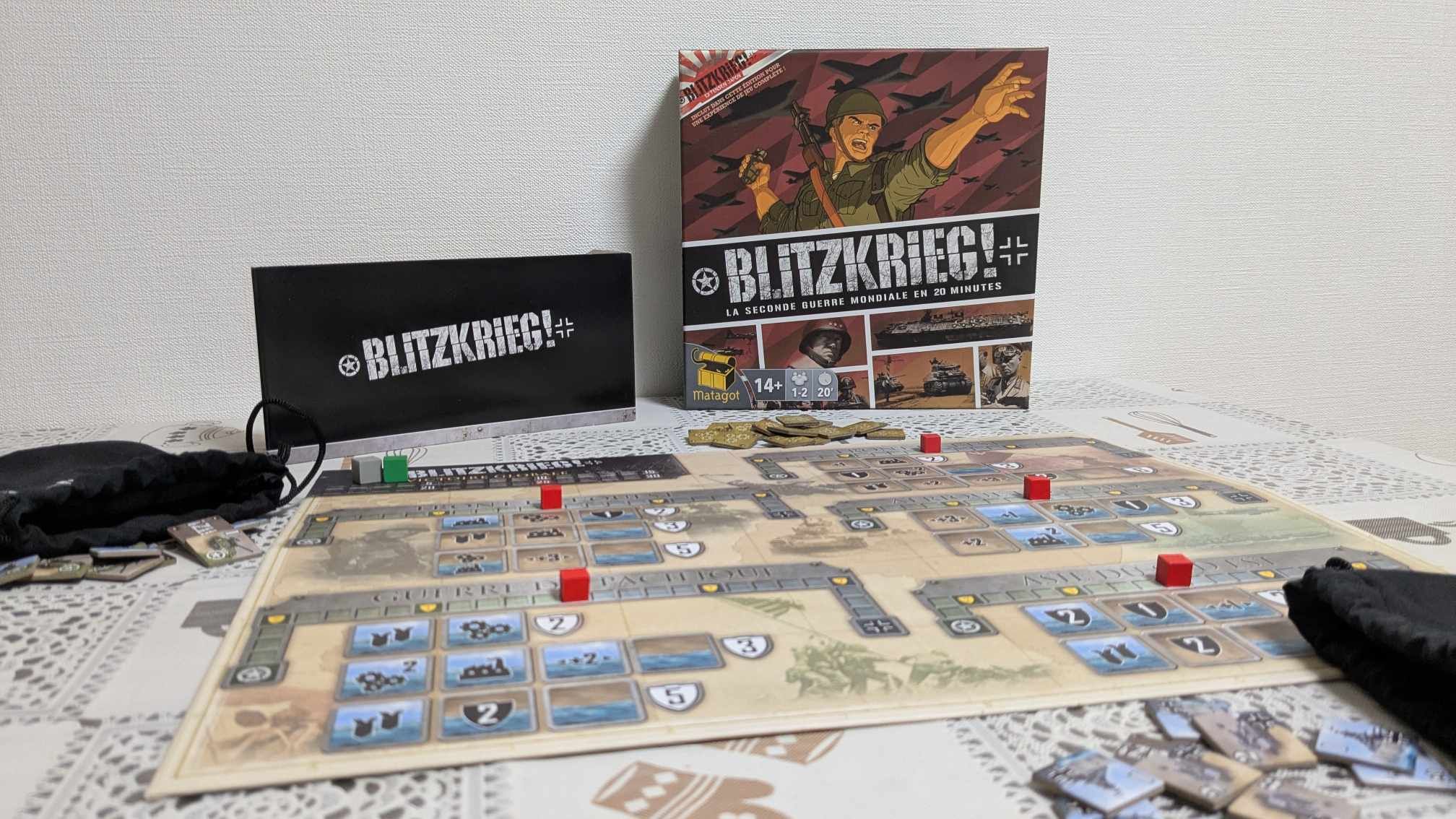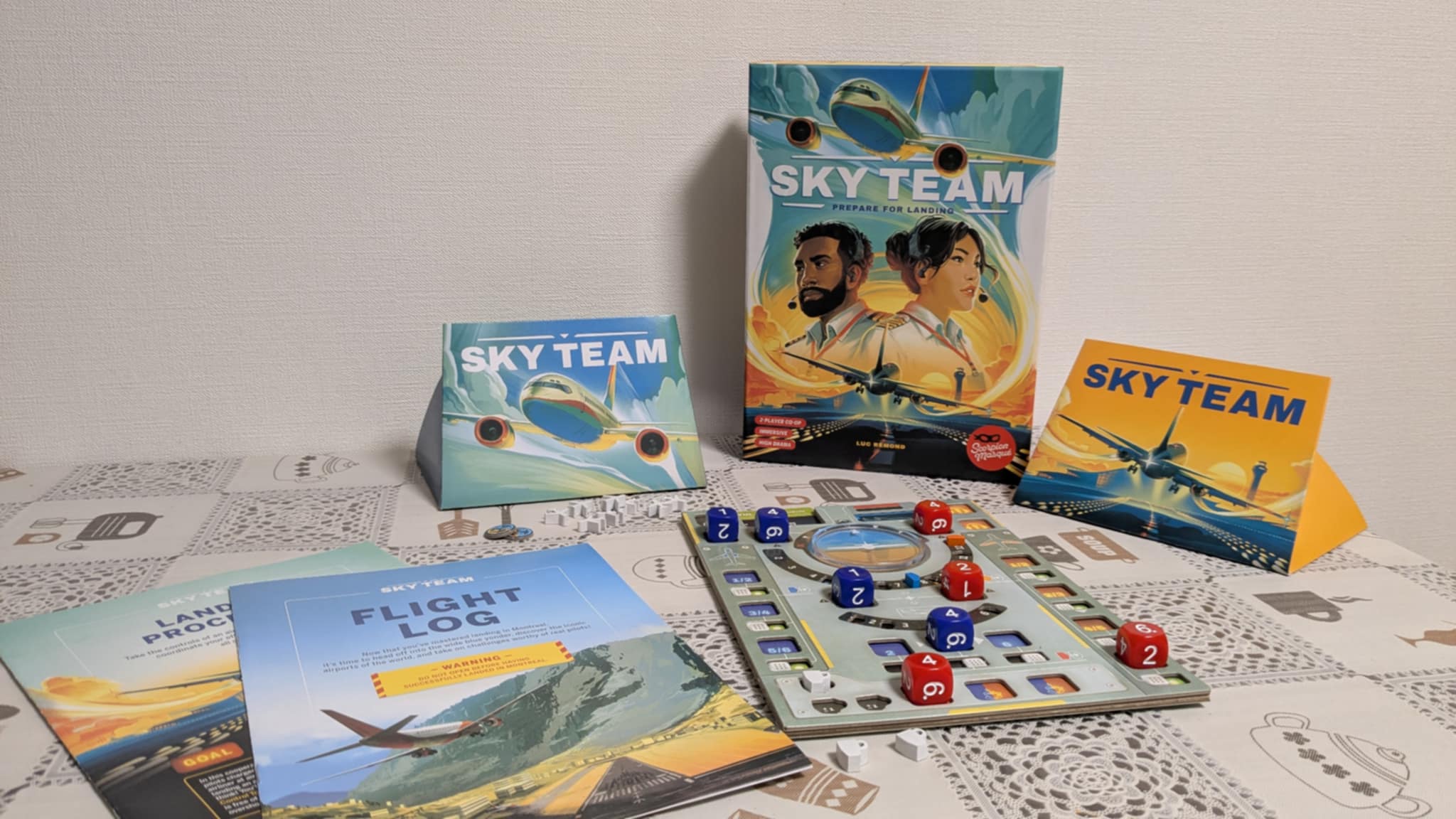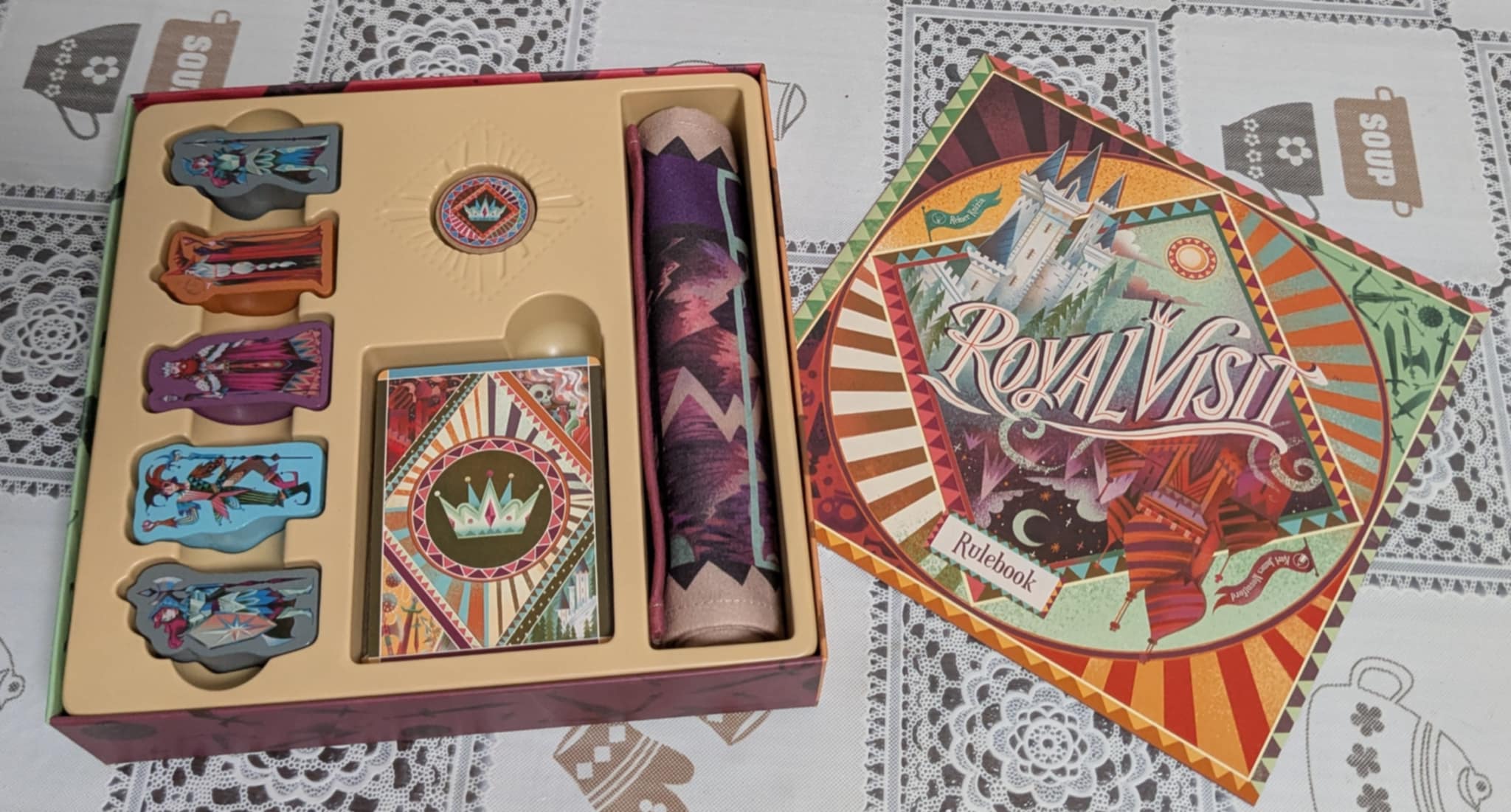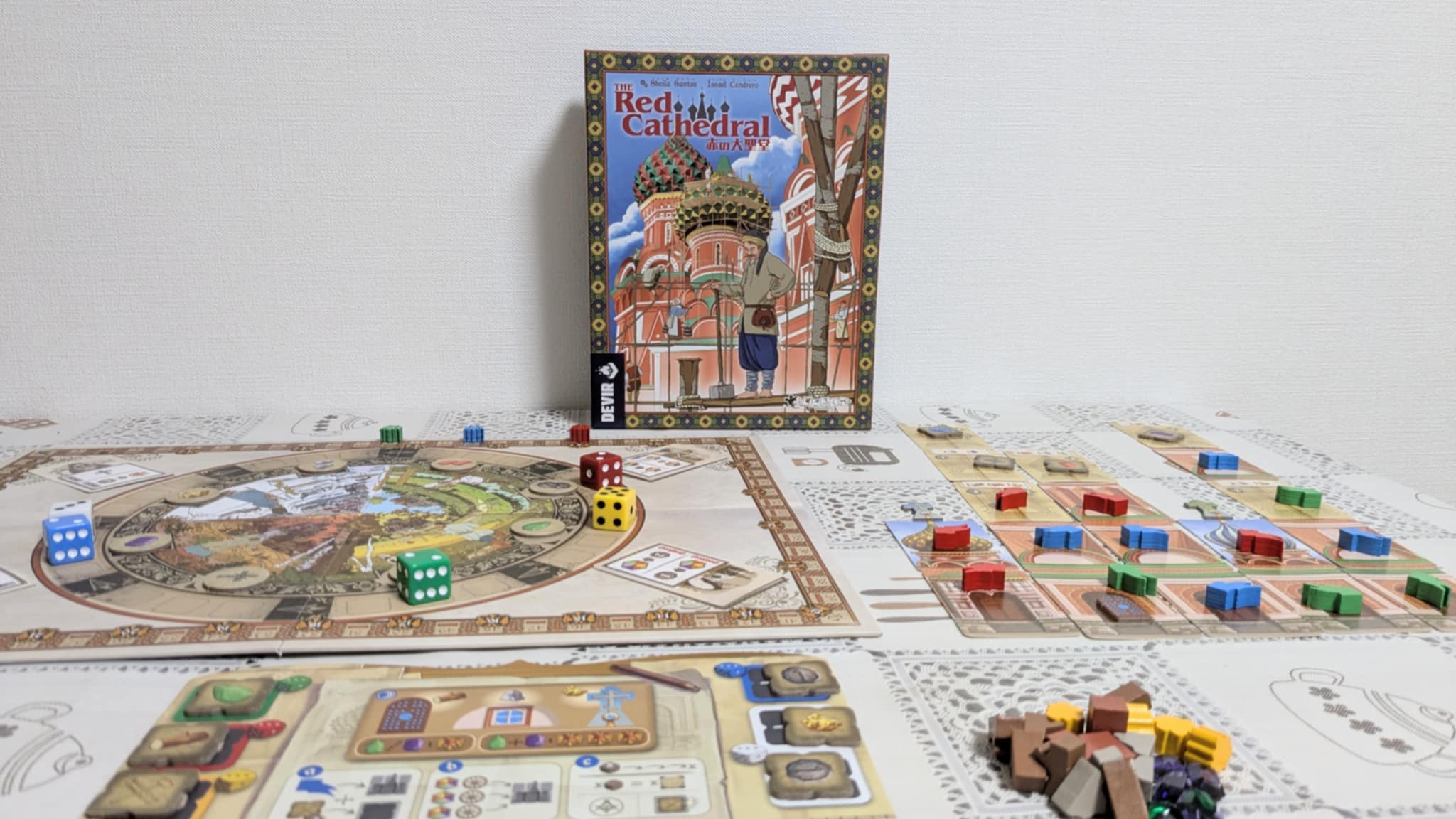Blitzkrieg! Board Game Review
Today we’re digging into one of the most compact yet strategic war simulations on the modern tabletop: Blitzkrieg!: World War Two in 20 Minutes, designed by Paolo Mori. Whether you’re a history buff, a strategy gamer, or someone who thinks they don’t have time for a full-scale war on a weeknight, this board game is here to prove you wrong.
What is Blitzkrieg?
Blitzkrieg! is a tightly focused two-player board game that manages to condense the entire scope of WWII into just twenty minutes. Players take on the roles of the Allied and Axis forces, battling over multiple theaters of war by deploying military units drawn from a bag. There are no dice, no long setup, and no waiting around. Every turn is a quick decision with long-term consequences, making it one of the most clever entries in the world of modern war games.
The game features:
- Player Count: 2 players
- Playtime: 20–30 minutes
- Complexity: Medium-light
- Mechanics: Bag-building, tactical placement, tug-of-war scoring
- Theme: World War Two, alternate history (with the Nippon Expansion)
The brilliance of Blitzkrieg is how it distills strategic warfare into a fast-paced format that still feels like a grand campaign. Each unit token deployed contributes to shifting the tides of war across five major theaters of operation, offering dynamic interaction and meaningful choices every turn.
Now, let’s welcome Blitzkrieg to the hot seat and hear what this pocket-sized WWII powerhouse has to say for itself.
Strategic Powers and Tactical Punches: Blitzkrieg Opens Fire
Me: Welcome to the table, Blitzkrieg! First off, you come out of the gate with energy. Right from turn one, you feel tactical and tight. What’s your secret?
Blitzkrieg: Cheers, Commander. I keep things sharp. Every move in my world is a calculated strike. You’re not just placing a token—you’re deciding which power to leverage, which front to influence, and how to mess with your opponent’s strategy, all in the same breath.
Me: The powers across the board really jump out. They feel like tactical tools—every one of them tempting.
Blitzkrieg: That’s the idea. Think of it like going on a strategic shopping spree, except instead of groceries, you’re picking up airstrikes, research, factories, and navy power. Every spot on my board offers something valuable. But here’s the twist—you can’t have it all. That’s where the tension begins.
Me: And then there are the unit powers themselves. Some look weak on paper, but in the right moment…
Blitzkrieg: You’re talking about the generals, aren’t you? A humble strength of 1, but drop them into a theater you’ve already invested in, and suddenly they’re a sledgehammer. I love doing that—letting you feel clever for spotting the moment to strike.
Me: What about the researched pieces?
Blitzkrieg: Strong but not broken. That’s the balance. They feel like power-ups earned through effort, and they create a great moment of escalation. You’re not just playing stronger pieces—you’re evolving your strategy mid-game.
Me: So, placing a token isn’t just about strength—it’s a decision packed with cascading effects.
Blitzkrieg: Exactly. It’s all about that snappy, satisfying core: place a piece, trigger an effect, keep the tension high. That’s how I keep a world war under 30 minutes—and still make every turn feel like a battle won or lost.
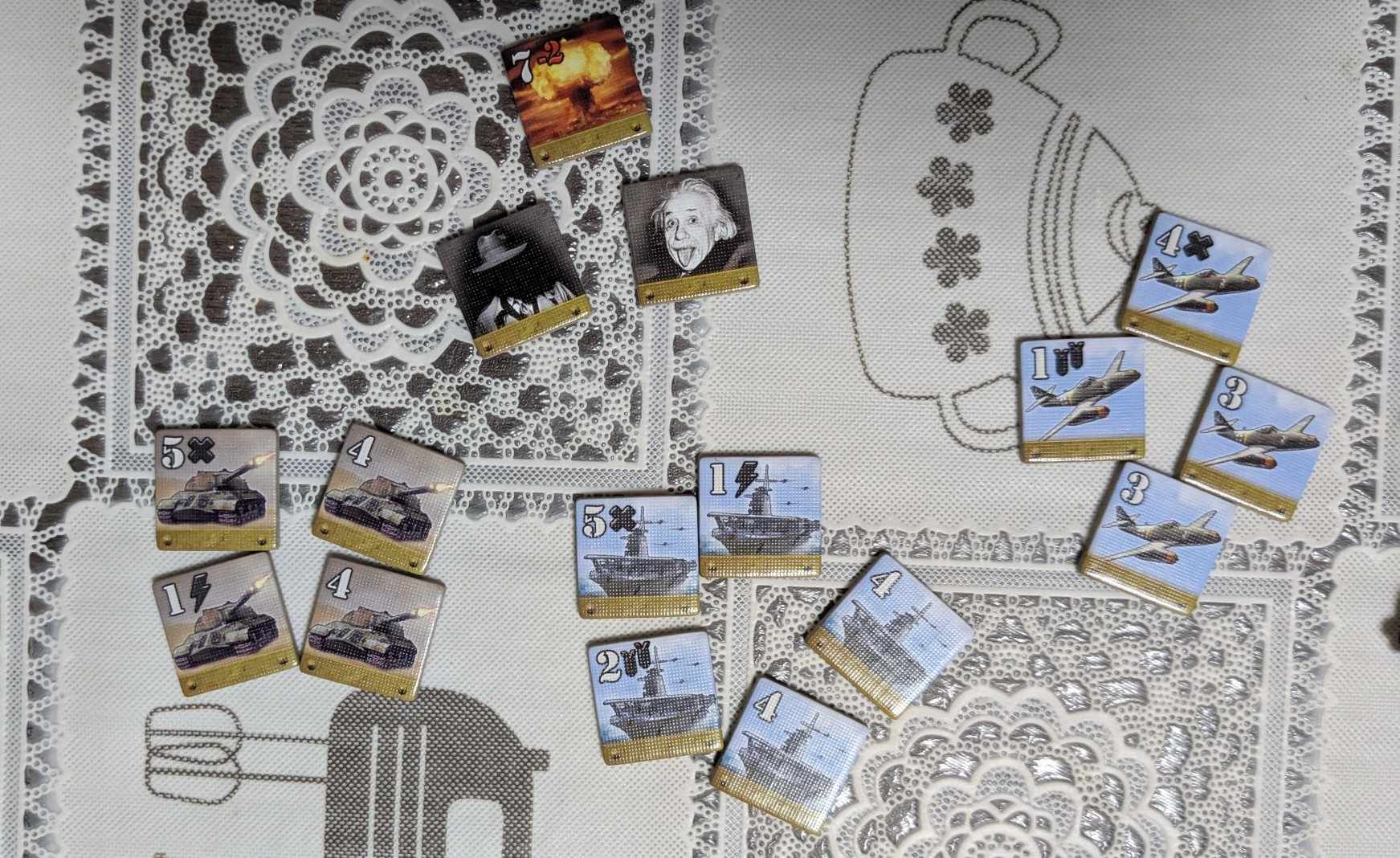
Timing, Tempo, and the Tug-of-War of WWII
Me: Blitzkrieg, your subtitle is “World War Two in 20 Minutes,” which is bold. So, how exactly do you evoke the scale and strategy of a global conflict in such a short span?
Blitzkrieg: You know what they say—less is more. I condense the chaos of WWII into five simultaneous theaters of war. It’s a multi-front tug-of-war, and you’re only pulling one rope per turn. That constraint? That’s what creates the drama.
Me: It’s clever. You’re asking players to pick their battles, quite literally.
Blitzkrieg: Exactly. Each theater—Europe, Pacific, Africa, Middle East, Southeast Asia—is a front line begging for attention. But you only get one move at a time. That’s the tension of WWII: not enough resources, too many fires to put out.
Me: And when a campaign in one of those theaters closes out?
Blitzkrieg: Now that’s a twisty moment. Ending a campaign gives you those sweet victory points. But it also triggers a new campaign—with fresh powers up for grabs. If you’re the one closing it out, your opponent gets first dibs next round. That’s a delicious dilemma, isn’t it?
Me: Unless they’re busy elsewhere?
Blitzkrieg: Bingo. If they’ve got bigger problems on another front, you just might sneak it in. That’s the tempo game. It’s about pressure—sometimes subtle, sometimes overwhelming.
Me: Let’s talk Blitz planes. Playing two tokens in one turn feels explosive.
Blitzkrieg: Oh, it is. A quick strike—take a power, swing the strength. But it comes at a cost. You lose a token, and in a game with a limited hand size, that hurts later. It’s a tactical nuke wrapped in a timing puzzle. Use it too early and you’ll be scrambling for options when it counts.
Me: So in the end, Blitzkrieg isn’t just about power—it’s about knowing when to pull the trigger.
Blitzkrieg: Now you’re speaking my language.
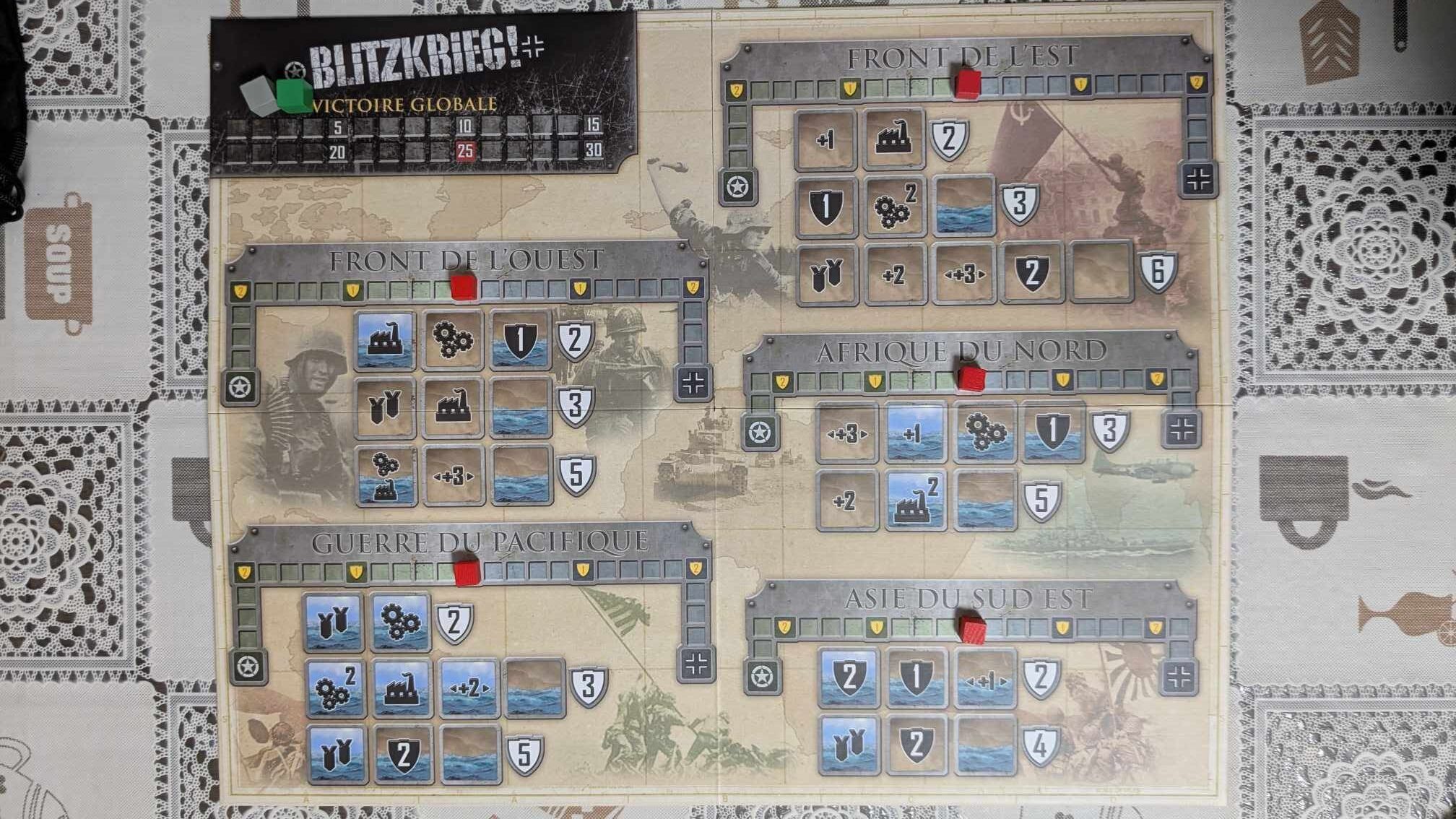
From Expansion to Compression: How Blitzkrieg Keeps the Strategy Tight
Me: Blitzkrieg, one thing I really admire about you is how streamlined and fast-paced you are—even though there’s a lot going on. How do you manage to keep the decision-making tight while still offering such rich strategic gameplay?
Blitzkrieg: That’s a great observation. My secret lies in how I expand and compress the decision space over time. In the early game, each campaign starts with just two or three deployment slots. It’s tight, it’s focused. But as the war escalates, the later campaigns stretch wider with four or even five slots. It gives players more space to maneuver—at first.
Me: Doesn’t that ever feel overwhelming for players, especially when more options appear?
Blitzkrieg: It could, but I have a trick for that—limited hand size. Players only hold a few tokens at a time, and each unit has terrain restrictions. You can’t just play anything anywhere. That natural constraint keeps the game snappy and decisions sharp.
Me: Ah, so even when the board gets wider, players don’t get bogged down with too many choices?
Blitzkrieg: Exactly. Plus, my bag-building system adds just the right amount of unpredictability. You’re not drawing from a full deck—you’re drawing from a bag. So while you can influence what’s in it, you never fully control what comes out. That moment you draw a perfect unit or miss the one you needed? That’s where the tension lives.
Me: I’ve noticed hand size changes throughout the game too—how does that play into the strategy?
Blitzkrieg: That’s where my tempo shines. Actions like blitzing let you double-place, but they cost you a token. Bombing removes an enemy unit, but also thins the pool. Manufacturing adds more tokens to your bag, giving you flexibility later. It’s all about timing and tempo. Every decision has ripple effects.
Me: And as fronts start to close?
Blitzkrieg: The space contracts again. Fewer fronts, fewer moves, but each one matters more. That final stretch? It’s sharp. Every piece you place could be a game winner or the moment your plans collapse. It’s a shrinking battlefield—and a growing sense of urgency.
Me: So even though the battlefield looks vast, you make sure it always plays with clarity and pressure?
Blitzkrieg: That’s the art of war—and of great board game design.
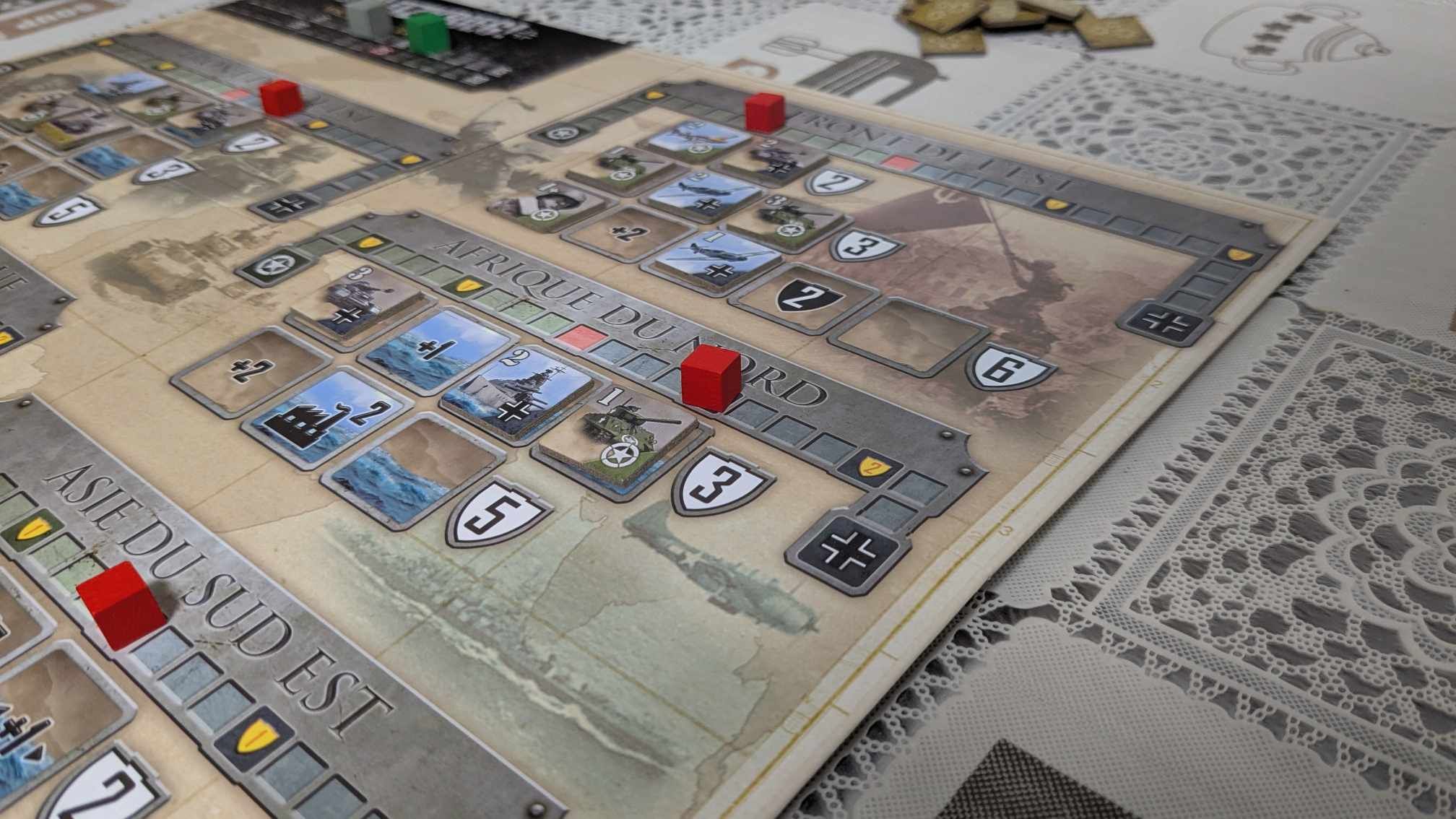
The Tension Builds: Escalation and the Road to Victory
Me: Blitzkrieg, I’ve noticed that your pacing doesn’t just stay sharp—it ramps up. Can you tell me about how the game arc evolves?
Blitzkrieg: With pleasure. My design leans into escalation. Early campaigns? They’re important, but the later ones—those are where the real fireworks happen. Not only do they offer more points, but the powers unlocked in these regions are significantly stronger. It’s the natural way of war: as the world conflict expands, so too does the weight of every decision.
Me: So the stakes just keep rising?
Blitzkrieg: Precisely. It’s a classic arc of tension. At first, players are skirmishing—testing the waters. But as fronts fall and campaigns close, the remaining ones become more and more vital. Every placement becomes heavier with implications, because there’s less room for recovery.
Me: That makes a lot of sense. And by then, players have fewer unknowns, right?
Blitzkrieg: Correct. As the game progresses, your remaining pieces are fewer, and you’ve probably drawn many of the critical tokens from your bag. There’s less fog of war, and more calculated decisions. I shift from early adaptability to late-game precision.
Me: And what happens when a front closes? How does that affect the flow?
Blitzkrieg: That’s where I tighten the screws. When a front is decided, all eyes move to what’s left. With fewer places to play and more points on the line, the pressure ramps up. Players can no longer ignore any front—every remaining space becomes a high-stakes decision.
Me: So it’s not just about escalation—it’s about compression too?
Blitzkrieg: Exactly. I start wide, grow bigger, and then squeeze tighter. It keeps the players on edge right through the final turn.
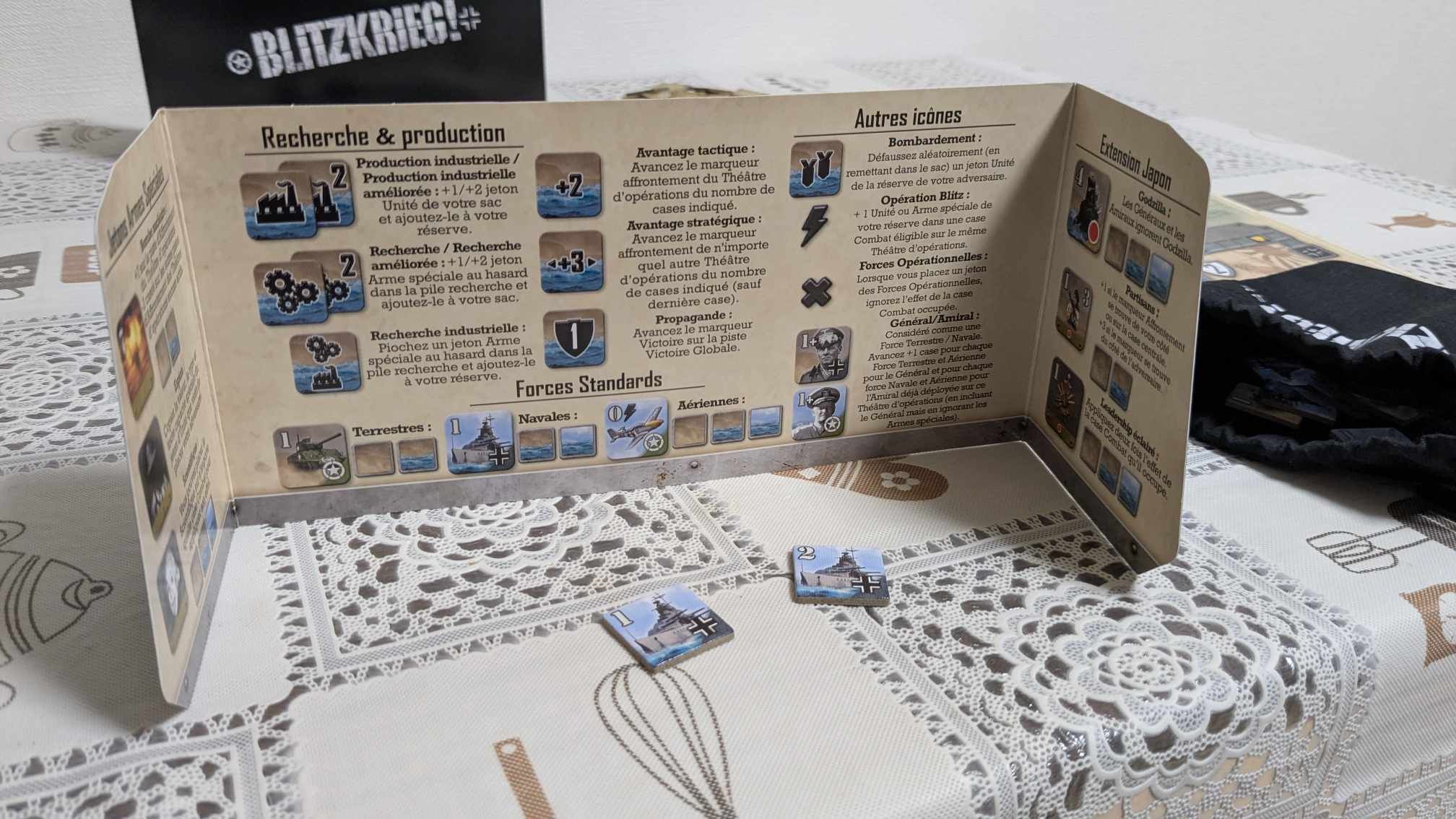
Fighting or Fleeing: Knowing When to Drop a Front in Blitzkrieg
Me: Let’s talk strategy. Blitzkrieg, you’re a game full of tactical choices—but what about the strategic big picture? Is there ever a time when it’s best to give up on a front?
Blitzkrieg: Absolutely. One of my favorite things to teach players is that sometimes the smartest move… is retreat. Every front in my world offers different rewards—be it points, powers, or Strategic Maneuver bonuses. But when your opponent clearly has the upper hand, it can be wise to redirect your focus elsewhere.
Me: That must be a tough call though. Letting go of a fight you’ve already invested in?
Blitzkrieg: It’s never easy. But the real brilliance lies in evaluating why a front is worth fighting for. Even if it’s lost, there may still be reasons to contest it. Denying your opponent a valuable reward—like a strategic maneuver that grants two placements or victory points—is often worth the effort.
Me: So you’re not just deciding where to win, but where to lose smartly?
Blitzkrieg: Precisely. I reward players who pay close attention. Some fronts might seem minor until you realize they’re hiding powers that swing other theaters of war. It’s that interconnected tension that adds depth. Winning the war isn’t always about dominating every battle—sometimes, it’s about losing well.
Me: That’s surprisingly nuanced for a 20-minute board game.
Blitzkrieg: That’s the charm. I may be short on time, but I’m never short on tactical complexity.
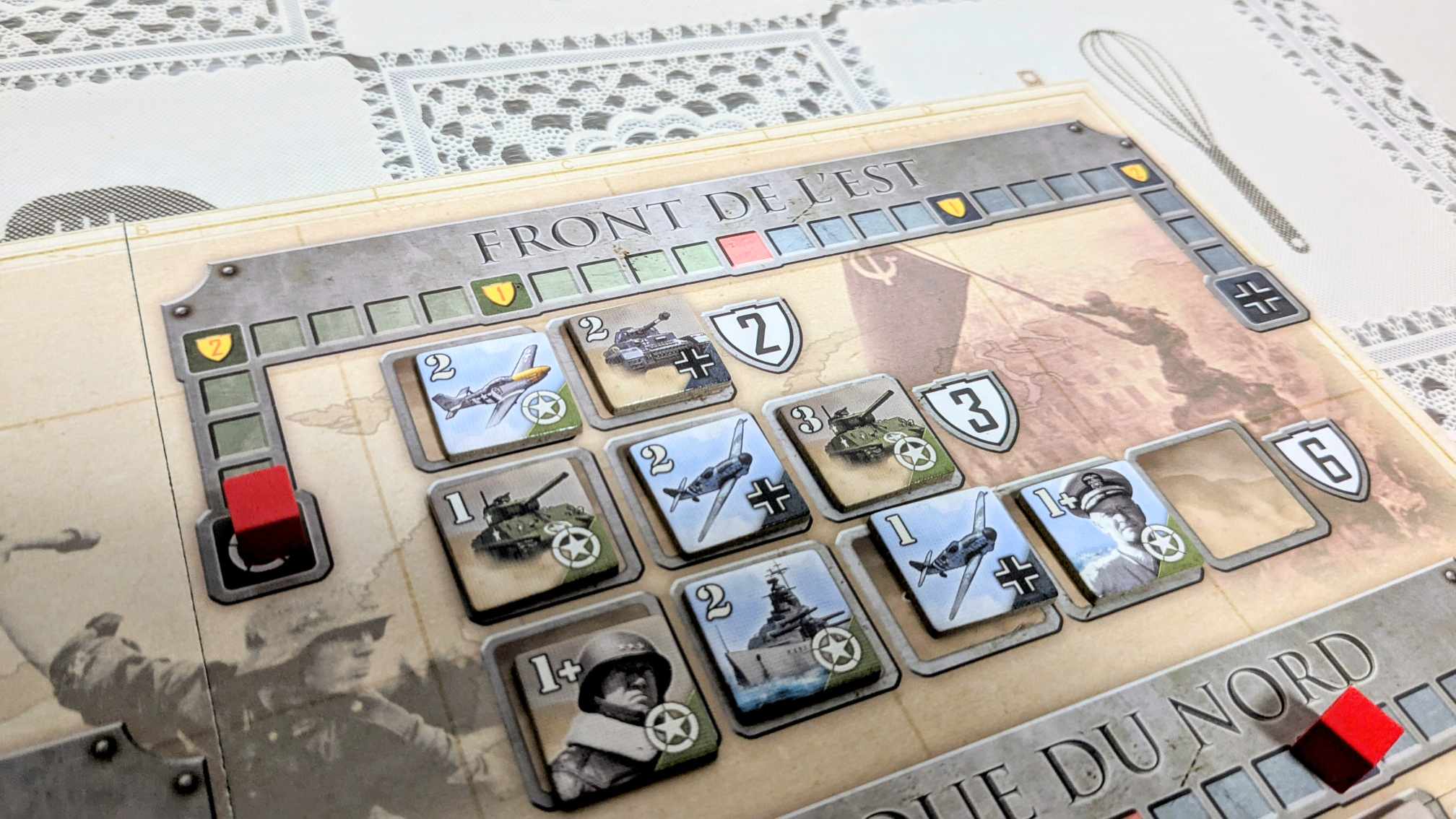
Blitzkrieg’s Drawbacks: A Few Cracks in the Armor
Me: Blitzkrieg, you’ve impressed me with your tactical flair and tight pacing—but let’s be fair. Every game has its flaws. Mind if we talk about yours?
Blitzkrieg: Of course. No operation is without its risks. Let’s address the big one first: my World War II theme. While I abstract things to a high level—no graphic content or gritty realism—it’s still a conflict-based theme. That alone can turn some players away. Those looking for a deeply historical war game might find me too breezy. And for players who avoid WWII themes entirely, my aesthetic might raise red flags.
Me: That makes sense. You also rely on bag drawing—how does that affect the strategy?
Blitzkrieg: I’ll admit it: I’m not purely strategic. My bag-building and tile-drawing mechanics introduce a healthy dose of randomness. That unpredictability adds excitement, tension, and bluffing—but it does make the game feel more tactical and psychological than a grand strategy simulation.
Me: Some players say the ending can feel anticlimactic?
Blitzkrieg: That’s a fair critique. My decision space narrows quickly near the end, and sometimes both players realize—only after a couple placements—that the game was actually decided two turns ago. It can feel like stumbling into a victory or defeat.
Me: That sounds frustrating—but not fatal?
Blitzkrieg: Far from it. Here’s the saving grace: I last 20 minutes. When a game is this short, players are far more forgiving. My pacing is so snappy, there’s always time for a rematch—and that’s where the real fun begins.

Final Verdict: Blitzkrieg—A Lightning Strike of Tactical Fun
Me: Blitzkrieg, thank you for joining us. Any final words for the readers out there deciding whether to enlist?
Blitzkrieg: Absolutely. I know who I am—and I’m proud of it. I’m not here to simulate entire wars across dozens of hours. I’m here to deliver World War in 20 Minutes. Tight, clever, and packed with snappy decisions.
If you’re looking for a deep, strategic war game filled with layers of long-term planning and sweeping control, I’ll be too light for your taste. But if you’re after a fast-playing, exciting tug-of-war that you can teach in five minutes and play again immediately after—then I’m your guy.
Me: So you’d say you’re more casual than complex?
Blitzkrieg: Exactly. I offer just enough bite for players to bluff, bait, and race to victory—without the brain burn.
Me: Thanks for coming, Blitzkrieg. I have a feeling we’ll be drawing up battle plans for a rematch soon.
Blitzkrieg: I’ll be ready. Just don’t blink—I might blitz you again.

Conclusion: Tactical Fun in a Tight Package
Blitzkrieg is proof that big things can come in small (and fast) packages. It may not satisfy fans of deeply strategic, historically intricate war games, but that’s not what it aims to do. Instead, it delivers a smart, punchy experience full of tension, timing, and tactical plays—all in the time it takes to finish your coffee.
For those who enjoy Paolo Mori’s crisp designs, Caesar: Seize Rome in 20 Minutes is another strong 2-player follow-up worth exploring. If you’re looking for something with more player interaction across a larger group, Libertalia offers an engaging shared space of pirate cunning. And for a different kind of two-player tension, Lost Cities remains one of this site’s absolute favorites—easy to teach, impossible to master.
With a bold theme, streamlined gameplay, and bite-sized battles that rarely overstay their welcome, Blitzkrieg holds its own as a modern tactical gem.
Final Rating: 8/10
✅ Pros:
Fast-paced core loop with satisfying decisions
Escalating campaigns build natural tension
Excellent gameplay in a tight 20-minute frame
❌ Cons:
WWII theme isn’t for everyone (and may be too abstract for war game purists)
Randomness can lead to unsatisfying or anticlimactic endings
Strategic depth is limited compared to heavier war titles
Whether you’re a casual tactician or a seasoned strategist looking for a lighter duel, Blitzkrieg is well worth a go—just don’t expect to out-plan your opponent in every battle. Sometimes, it’s all about when and where to strike.

